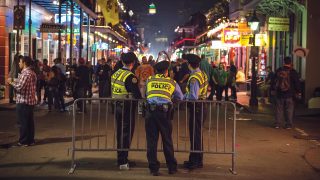
As mass shootings become more of a frequent occurrence, law enforcement is learning from each incident and adapting their strategies.
One of these strategies was highlighted by the recent shooting in a Boulder, Colorado, grocery store that left 10 dead, including police officer Eric Talley. Talley was the first officer on the scene. According to police scanner recordings, Talley would have known that there were victims down in the parking lot and shots being fired within the store.
He was faced with a decision to go in and confront the shooter or wait for backup. He decided heroically to act, but sacrificed his life in the process.
An active shooter call, according to experts, is the “most dangerous call.” Talley answered this call without hesitation.
The question is: What should officers do when receiving such a call? Experts like Pete Blair, executive director with Advanced Law Enforcement Rapid Response Training, and Chuck Wexler, executive director of the Police Executive Research Forum, believe that officers should act like Talley.
Blair told USA Today, “It’s the most dangerous call there is in law enforcement. When you hear that gunfire going off and people are being murdered, there’s an expectation for an officer to stop it. … He’s making a decision to go directly toward the threat.”
Wexler said Talley’s actions were risky but necessary. “These things happen so quickly that the first officer can’t wait. The officer has to engage. It’s highly risky, but unfortunately, in situations like this, seconds matter.”
He continued, “Ultimately, this is what differentiates police officers from everyone else. Sometimes, they have to prepare to lose their lives to save others.”
The way police respond to mass shootings has changed over time. Before the Columbine High School shooting, police were advised to call in backup from SWAT teams, specialized tactical units trained and armed to fight heavily armed assassins, during an active shooting.
However, after criticism for the way police acted during the Columbine shooting – opting to surround the shooters and stand by for tactical plans and resources rather than take out the shooters right way – law enforcement’s conservative strategy changed.
According to USA Today, a 2018 model policy on mass shootings by the International Association of Police Chiefs solidified the changes in protocols and training.
The guide states, “Many law enforcement executives began reconsidering the wisdom of limiting the role of first responders at critical incidents to containment and related basic functions.”
Now the consensus among law enforcement training experts is that a first responder at a shooting rampage should take immediate action if lives are at risk.
The model policy states, “Time lost by delayed action is likely to result in additional casualties. A minimum of three officers is recommended to conduct a tactical deployment. However, this might not always be possible. Individual officers or pairs of officers may need to take steps to stop a threat when a delay in acquiring backup is likely.”
According to Blair, every officer faced with that call must weigh the chance of success against the threat of further deaths. He called it a balancing act of “courage” and “prudence,” and a “moral dilemma.”
Blair found from a not-yet-published study that from 2000 to 2018, there were 277 active shooter events in the USA, and a total of 78 officers were shot. Of those, 21 died.
It is clear that the risks are high in these cases, but Talley acted the way all officers should.
Wexler said his organization helped Palm Beach County review its active-shooter policies in the aftermath of the Parkland, Florida shooting that left 17 dead. The determination was that when someone is killing people and the first officer arrives, “the expectation is you will go in. … Waiting for additional resources costs lives.”
Talley is survived by his seven children. His father said, “Didn’t surprise me he was the first one there.”





